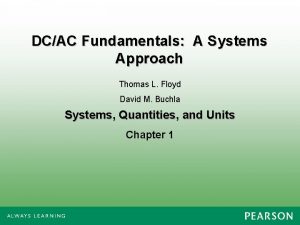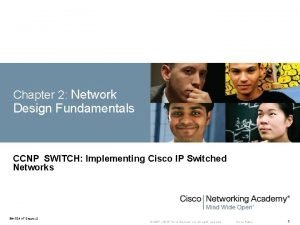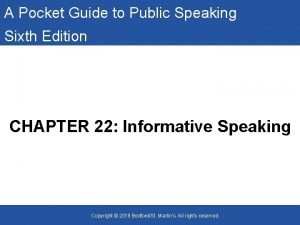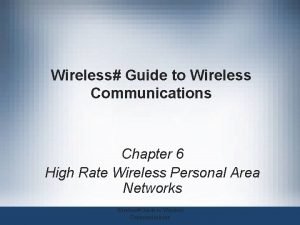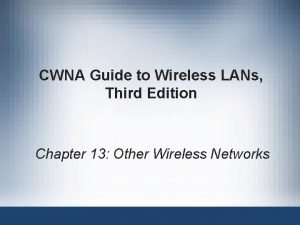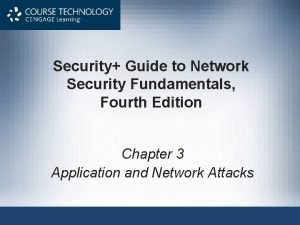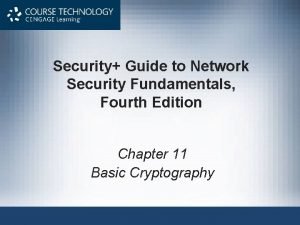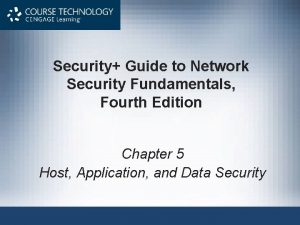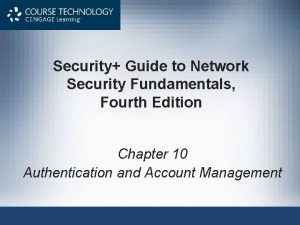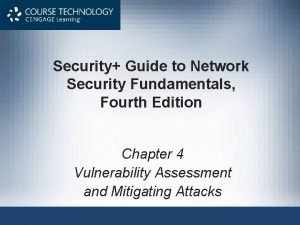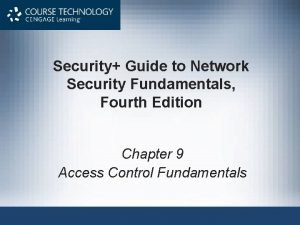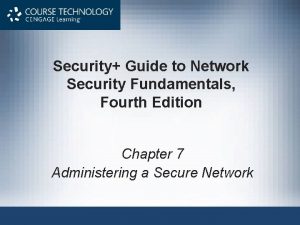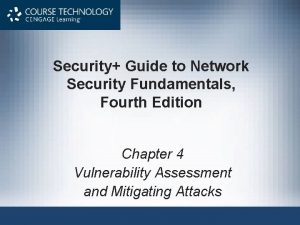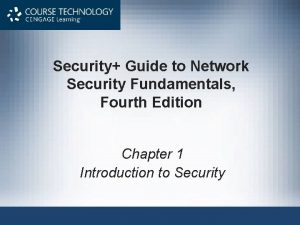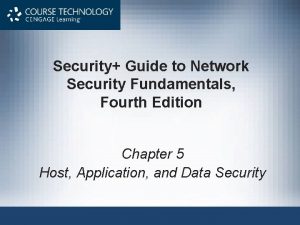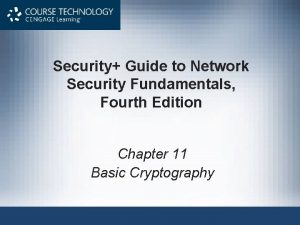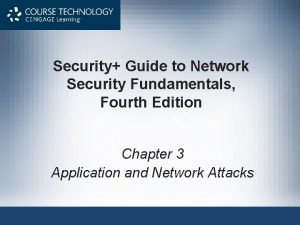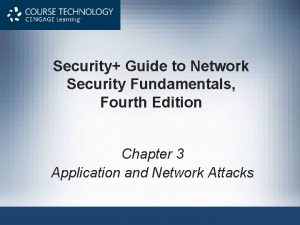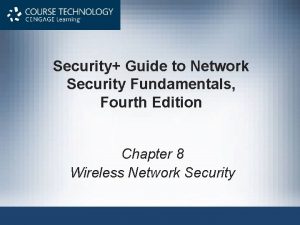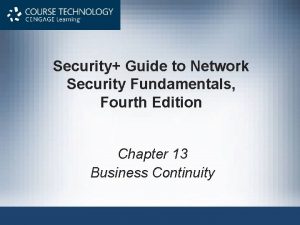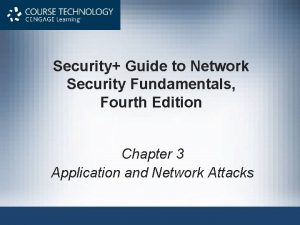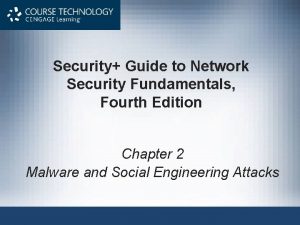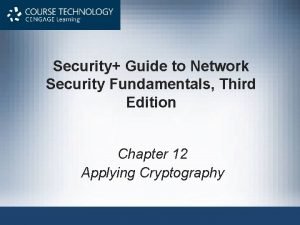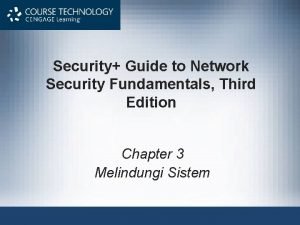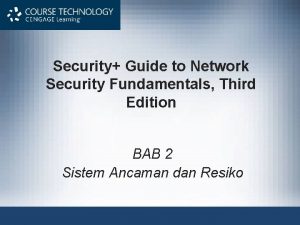Security Guide to Network Security Fundamentals Fourth Edition





















































- Slides: 53

Security+ Guide to Network Security Fundamentals, Fourth Edition Chapter 5 Host, Application, and Data Security

Objectives • List the steps for securing a host computer • Define application security • Explain how to secure data using loss prevention Security+ Guide to Network Security Fundamentals, Fourth Edition 2

Securing the Host • Three important elements to secure – Host (network server or client) – Applications – Data • Securing the host involves: – – Protecting the physical device Securing the operating system software Using security-based software applications Monitoring logs Security+ Guide to Network Security Fundamentals, Fourth Edition 3

Securing Devices • Prevent unauthorized users from gaining physical access to equipment • Aspects of securing devices – Physical access security – Host hardware security – Mobile device security Security+ Guide to Network Security Fundamentals, Fourth Edition 4

Securing Devices (cont’d. ) • Physical security – Restricting access to equipment areas • Hardware locks – Standard keyed entry lock provides minimal security – Deadbolt locks provide additional security • Keyed locks can be compromised if keys lost, stolen, or duplicated • Lock Picking • http: //www. youtube. com/watch? v=wemp-8 WD 9 d. Y&feature=related • • http: //www. youtube. com/watch? v=r. ZTtu. Xkr. Xjch http: //www. youtube. com/watch? v=j. Cz 3_lad. HNM http: //www. youtube. com/watch? feature=fvwp&v=Bn. S 6 le. Hf. B 2 c&NR=1 http: //www. youtube. com/watch? v=BP 2 WYhs 0 Eks&feature=related Security+ Guide to Network Security Fundamentals, Fourth Edition 5

Figure 5 -1 Residential keyed entry lock © Cengage Learning 2012 Figure 5 -2 Deadbolt lock © Cengage Learning 2012 Security+ Guide to Network Security Fundamentals, Fourth Edition 6

Securing Devices (cont’d. ) • Recommended key management procedures – – – Change locks after key loss or theft Inspect locks regularly Issue keys only to authorized users Keep records of who uses and turns in keys Keep track of issued keys Master keys should not have identifying marks Security+ Guide to Network Security Fundamentals, Fourth Edition 7

Securing Devices (cont’d. ) • Recommended key management procedures (cont’d. ) – Secure unused keys in locked safe – Set up key monitoring procedure – Mark duplicate master keys with “Do not duplicate” • Wipe out manufacturer’s serial number to prevent duplicates from being ordered Security+ Guide to Network Security Fundamentals, Fourth Edition 8

Securing Devices (cont’d. ) • Cipher lock – More sophisticated alternative to key lock – Combination sequence necessary to open door – Can be programmed to allow individual’s code to give access at only certain days or times – Records when door is opened and by which code – Can be vulnerable to shoulder surfing – Often used in conjunction with tailgate sensor Security+ Guide to Network Security Fundamentals, Fourth Edition 9

Figure 5 -3 Cipher lock © Cengage Learning 2012 Security+ Guide to Network Security Fundamentals, Fourth Edition 10

Securing Devices (cont’d. ) • Alternative access method: physical token – ID badge may contain bearer’s photo – ID badge emits a signal identifying the owner – Proximity reader receives signal • RFID tags – Can be affixed inside ID badge – Read by an RFID proximity reader • Badge can remain in bearer’s pocket Security+ Guide to Network Security Fundamentals, Fourth Edition 11

Figure 5 -4 RFID tag © Cengage Learning 2012 Figure 5 -5 Mantrap © Cengage Learning 2012 Security+ Guide to Network Security Fundamentals, Fourth Edition 12

Securing Devices (cont’d. ) • Access list – Record of individuals who have permission to enter secure area – Records time they entered and left • Mantrap – Separates a secured from a nonsecured area – Device monitors and controls two interlocking doors • Only one door may open at any time Security+ Guide to Network Security Fundamentals, Fourth Edition 13

Securing Devices (cont’d. ) • Video surveillance – Closed-circuit television (CCTV) • Video cameras transmit signal to limited set of receivers • Cameras may be fixed or able to move • Passive deterrent • Fencing – Barrier around secured area – Modern perimeter fences are equipped with other deterrents – 8’ with strands of barbed wire slanted at 45% angle Security+ Guide to Network Security Fundamentals, Fourth Edition 14

Table 5 -1 Fencing deterrents Security+ Guide to Network Security Fundamentals, Fourth Edition 15

Securing Devices (cont’d. ) • Hardware security – Physical security protecting host system hardware – Portable devices have steel bracket security slot • Cable lock inserted into slot and secured to device • Cable connected to lock secured to desk or immobile object • Laptops may be placed in a safe • Locking cabinets – Can be prewired for power and network connections – Allow devices to charge while stored Security+ Guide to Network Security Fundamentals, Fourth Edition 16

Figure 5 -6 Cable lock © Cengage Learning 2012 Security+ Guide to Network Security Fundamentals, Fourth Edition 17

Securing Devices (cont’d. ) • Mobile device security – Many security provisions that apply to laptops apply to mobile devices – http: //www. youtube. com/watch? v=as-CPdf-r. KI&feature=related • Mobile devices’ unique security features – Remote wipe / sanitation • Data can be remotely erased if device is stolen – GPS tracking • Can pinpoint location to within 100 meters Security+ Guide to Network Security Fundamentals, Fourth Edition 18

Securing Devices (cont’d. ) • Mobile devices’ unique security features (cont’d. ) – Voice encryption • Used to mask content of voice communication over a smartphone Security+ Guide to Network Security Fundamentals, Fourth Edition 19

Securing the Operating System Software • Five-step process for protecting operating system – – – Develop the security policy Perform host software baselining Configure operating system security and settings Deploy the settings Implement patch management Security+ Guide to Network Security Fundamentals, Fourth Edition 20

Securing the Operating System Software (cont’d. ) • Develop the security policy – Document(s) that clearly define organization’s defense mechanisms • Perform host software baselining – Baseline: standard or checklist against which systems can be evaluated – Configuration settings that are used for each computer in the organization Security+ Guide to Network Security Fundamentals, Fourth Edition 21

Securing the Operating System Software (cont’d. ) • Configure operating system security and settings – Hundreds of different security settings can be manipulated – Typical configuration baseline • Changing insecure default settings • Eliminating unnecessary software, services, protocols • Enabling security features such as a firewall Security+ Guide to Network Security Fundamentals, Fourth Edition 22

Securing the Operating System Software (cont’d. ) • Deploy the settings – Security template: collections of security configuration settings – Process can be automated • Group policy – Windows feature providing centralized computer management – A single configuration may be deployed to many users Security+ Guide to Network Security Fundamentals, Fourth Edition 23

Securing the Operating System Software (cont’d. ) • Operating systems have increased in size and complexity • New attack tools have made secure functions vulnerable • Security patch – General software update to cover discovered vulnerabilities Security+ Guide to Network Security Fundamentals, Fourth Edition 24

Table 5 -2 Estimated size of selected operating systems Security+ Guide to Network Security Fundamentals, Fourth Edition 25

Securing the Operating System Software (cont’d. ) • Hotfix addresses specific customer situation • Service pack accumulates security updates and additional features • Implement patch management – Modern operating systems can perform automatic updates • Patches can sometimes create new problems – Vendor should thoroughly test before deploying Security+ Guide to Network Security Fundamentals, Fourth Edition 26

Figure 5 -7 Microsoft Windows 7 automatic update options © Cengage Learning 2012 Security+ Guide to Network Security Fundamentals, Fourth Edition 27

Securing the Operating System Software (cont’d. ) • Automated patch update service – Manage patches locally rather than rely on vendor’s online update service • Advantages of automated patch update service – Administrators can force updates to install by specific date – Computers not on the Internet can receive updates – Users cannot disable or circumvent updates Security+ Guide to Network Security Fundamentals, Fourth Edition 28

Microsoft: WSUS Figure 5 -8 Automated patch update service © Cengage Learning 2012 Security+ Guide to Network Security Fundamentals, Fourth Edition 29

Securing with Anti-Malware Software • Anti-virus – Software that examines a computer for infections – Scans new documents that might contain viruses – Searches for known virus patterns • Weakness of anti-virus – Vendor must continually search for new viruses, update and distribute signature files to users • Alterative approach: code emulation – Questionable code executed in virtual environment Security+ Guide to Network Security Fundamentals, Fourth Edition 30

Anti-Spam • Spammers can distribute malware through email attachments • Spam can be used for social engineering attacks • Spam filtering methods – Bayesian filtering – Local host filtering • Blacklist • Whitelist – Blocking certain file attachment types Security+ Guide to Network Security Fundamentals, Fourth Edition 31

Pop-up Blockers and Anti-Spyware • Pop-up – Small window appearing over Web site – Usually created by advertisers • Pop-up blockers – – Separate program as part of anti-spyware package Incorporated within a browser Allows user to limit or block most pop-ups Alert can be displayed in the browser • Gives user option to display pop-up Security+ Guide to Network Security Fundamentals, Fourth Edition 32

Host-Based Firewalls • Firewall – Designed to prevent malicious packets from entering or leaving computers – May be hardware or software-based – Host-based software firewall runs on local system • Microsoft Windows 7 firewall – Three designations for networks: public, home, or work – Users can configure settings for each type separately Security+ Guide to Network Security Fundamentals, Fourth Edition 33

Monitoring System Logs • Log: record of events that occur • Log entries – Contain information related to a specific event • Audit log can track user authentication attempts • Access log can provide details about requests for specific files • Monitoring system logs – Useful in determining how an attack occurred and whether successfully resisted Security+ Guide to Network Security Fundamentals, Fourth Edition 34

Monitoring System Logs (cont’d. ) • Logs that record all activity from network devices or programs: – Used in operations, general audits, and demonstrating regulatory compliance • Logs for system security – Operating system logs – Security application logs Security+ Guide to Network Security Fundamentals, Fourth Edition 35

Monitoring System Logs (cont’d. ) • System event logs record: – – Client requests and server responses Usage information Account information Operational information • Security application logs – Anti-virus software log – Automated patch update service log Security+ Guide to Network Security Fundamentals, Fourth Edition 36

Figure 5 -9 Microsoft system event and audit record log viewer © Cengage Learning 2012 Security+ Guide to Network Security Fundamentals, Fourth Edition 37

Monitoring System Logs (cont’d. ) • Benefits of monitoring system logs – Identify security incidents, policy violations, fraudulent activity – Provide information shortly after event occurs – Provide information to help resolve problems – Help identify operational trends and long-term problems – Provide documentation of regulatory compliance Security+ Guide to Network Security Fundamentals, Fourth Edition 38

Figure 5 -10 Anti-virus log © Cengage Learning 2012 Security+ Guide to Network Security Fundamentals, Fourth Edition 39

Application Security • Aspects of securing applications – Application development security – Application hardening – Patch management Security+ Guide to Network Security Fundamentals, Fourth Edition 40

Application Development Security • Security for applications must be considered through all phases of development cycle • Application configuration baselines – Standard environment settings can establish a secure baseline – Includes each development system, build system, and test system – Must include system and network configurations Security+ Guide to Network Security Fundamentals, Fourth Edition 41

Application Development Security (cont’d. ) • Secure coding concepts – Coding standards increase applications’ consistency, reliability, and security – Coding standards useful in code review process • Errors (exceptions) – Faults that occur while application is running – Response should be based on the error – Improper handling can lead to application failure or insecurity Security+ Guide to Network Security Fundamentals, Fourth Edition 42

Application Development Security (cont’d. ) • Error handling practices to avoid – Failing to check return codes or handle exceptions • Or improperly checking them – Handling all return codes or exceptions in the same manner – Divulging potentially sensitive data in error information Security+ Guide to Network Security Fundamentals, Fourth Edition 43

Application Development Security (cont’d. ) • Verify user responses to the application – Could cause program to abort – Necessary to check for XSS, SQL, or XML injection attacks • Input validation – Performed after data entered but before destination is known – Not possible to know which characters are potentially harmful Security+ Guide to Network Security Fundamentals, Fourth Edition 44

Application Development Security (cont’d. ) • Escaping (output encoding) – Preferred method for trapping user responses – Ensures characters are treated as data • Not relevant to the application • Fuzz testing (fuzzing) – Software technique that deliberately provides invalid, unexpected, or random data inputs – Monitor to ensure all errors are trapped Security+ Guide to Network Security Fundamentals, Fourth Edition 45

Application Development Security (cont’d. ) • Application hardening – Intended to prevent exploiting vulnerabilities Table 5 -3 Attacks based on application vulnerabilities Security+ Guide to Network Security Fundamentals, Fourth Edition 46

Application Development Security (cont’d. ) • Patch management – Rare until recently – Users unaware of the existence of patches or where to acquire them – More application patch management systems are being developed today Security+ Guide to Network Security Fundamentals, Fourth Edition 47

Securing Data • Work today involves electronic collaboration – Data must flow freely – Data security is important • Data loss prevention – System of security tools used to recognize and identify critical data and ensure it is protected • review “Right Management Services (RMS)” – Goal: protect data from unauthorized users Security+ Guide to Network Security Fundamentals, Fourth Edition 48

Securing Data (cont’d. ) • Data loss prevention typically examines: – Data in use (example: being printed) – Data in motion (being transmitted) – review “IPSec” – Data at rest (stored) – review “Bit. Locker” & “EFS” • Content inspection – Security analysis of transaction – Takes context into account Security+ Guide to Network Security Fundamentals, Fourth Edition 49

Figure 5 -11 DLP architecture © Cengage Learning 2012 Security+ Guide to Network Security Fundamentals, Fourth Edition 50

Figure 5 -12 DLP report © Cengage Learning 2012 Security+ Guide to Network Security Fundamentals, Fourth Edition 51

Summary • Physical access security includes door locks of various types • Portable devices can be secured with a cable lock • Remote wipe / sanitation can erase device contents from a distance if stolen • Security policy must be created, then a baseline can be established • Third-party anti-malware software can provide added security Security+ Guide to Network Security Fundamentals, Fourth Edition 52

Summary (cont’d. ) • Monitoring system logs is useful in determining how an attack occurred • Protecting applications that run on hardware – Create configuration baselines – Secure coding concepts • Data loss prevention (DLP) can identify critical data, monitor and protect it – Works through content inspection Security+ Guide to Network Security Fundamentals, Fourth Edition 53
 Security guide to network security fundamentals
Security guide to network security fundamentals Security guide to network security fundamentals
Security guide to network security fundamentals Security guide to network security fundamentals
Security guide to network security fundamentals Computer security fundamentals 4th edition
Computer security fundamentals 4th edition Project 2 fourth edition
Project 2 fourth edition Pathways algebra 2 fourth edition answer key
Pathways algebra 2 fourth edition answer key Ethics in information technology fourth edition
Ethics in information technology fourth edition Ethics in information technology 6th edition answers
Ethics in information technology 6th edition answers Project 4 fourth edition
Project 4 fourth edition Discrete math susanna epp
Discrete math susanna epp Expert systems: principles and programming, fourth edition
Expert systems: principles and programming, fourth edition William stallings network security essentials 5th edition
William stallings network security essentials 5th edition Modulo table
Modulo table Cryptography and network security 6th edition pdf
Cryptography and network security 6th edition pdf Cryptography and network security 4th edition
Cryptography and network security 4th edition Network security essentials 5th edition
Network security essentials 5th edition Pearson cryptography and network security
Pearson cryptography and network security Fundamentals of information systems 9th edition
Fundamentals of information systems 9th edition Fundamentals of information systems 9th edition
Fundamentals of information systems 9th edition Fluid mechanics fundamentals and applications 3rd edition
Fluid mechanics fundamentals and applications 3rd edition Digital fundamentals floyd
Digital fundamentals floyd Machining fundamentals 10th edition
Machining fundamentals 10th edition Fundamentals of organizational communication 9th edition
Fundamentals of organizational communication 9th edition Fundamentals of organizational communication 9th edition
Fundamentals of organizational communication 9th edition Sujata madan
Sujata madan Floyd digital fundamentals ppt
Floyd digital fundamentals ppt Floyd digital fundamentals 10th edition pdf
Floyd digital fundamentals 10th edition pdf Dc/ac fundamentals 1st edition
Dc/ac fundamentals 1st edition Management fundamentals 8th edition
Management fundamentals 8th edition Fundamentals of information systems 9th edition
Fundamentals of information systems 9th edition Fundamentals of corporate finance third canadian edition
Fundamentals of corporate finance third canadian edition Fundamentals of corporate finance fifth edition
Fundamentals of corporate finance fifth edition Fundamentals of corporate finance 6th edition
Fundamentals of corporate finance 6th edition Abnormal psychology comer 9th edition
Abnormal psychology comer 9th edition Fundamentals of information systems 9th edition
Fundamentals of information systems 9th edition Fundamentals of heat and mass transfer 4th edition
Fundamentals of heat and mass transfer 4th edition The fundamentals of political science research 2nd edition
The fundamentals of political science research 2nd edition Osi security architecture with neat diagram
Osi security architecture with neat diagram Wireless security in cryptography
Wireless security in cryptography Electronic mail security in network security
Electronic mail security in network security Mis chapter 6
Mis chapter 6 Zulily case study
Zulily case study Private security
Private security Intermediary devices
Intermediary devices Campus network design fundamentals
Campus network design fundamentals Florida real estate broker's guide
Florida real estate broker's guide Florida real estate broker's guide 6th edition
Florida real estate broker's guide 6th edition Pocket guide to public speaking
Pocket guide to public speaking Wpan security
Wpan security Marking bad clusters data hiding technique
Marking bad clusters data hiding technique Prehospital emergency care 11th edition
Prehospital emergency care 11th edition The no brokerage relationship notice must be disclosed
The no brokerage relationship notice must be disclosed Florida real estate broker's guide 6th edition
Florida real estate broker's guide 6th edition Cwna guide to wireless lans 3rd edition
Cwna guide to wireless lans 3rd edition



























